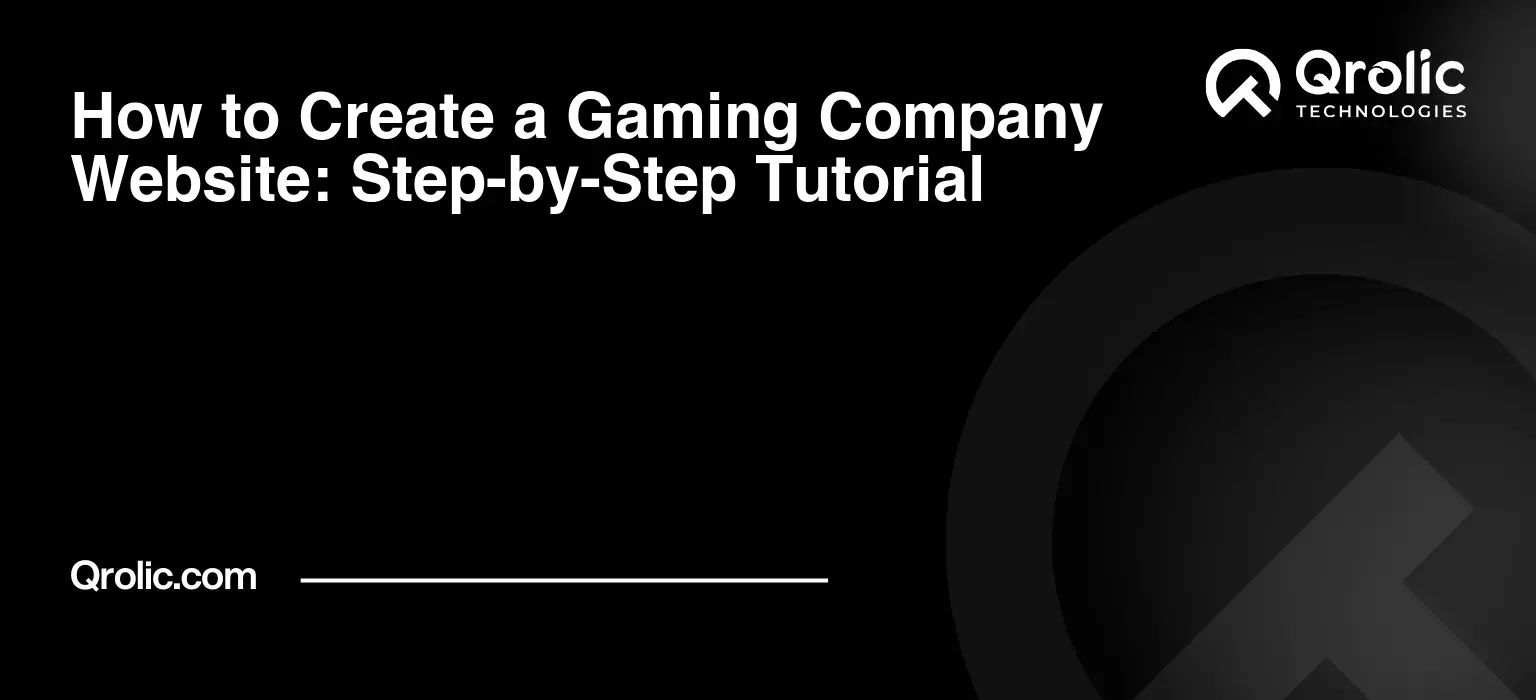Quick Summary:
- Plan your gaming website goals and audience first.
- Design for visual appeal and great user experience.
- Create engaging content and optimize for search engines.
- Test thoroughly, then consistently maintain your website.
Table of Contents
- 1. Laying the Foundation: Planning Your Gaming Company Website
- 1.1 Defining Your Target Audience and Website Goals
- 1.2 Competitor Analysis: What Are Other Gaming Companies Doing?
- 1.3 Domain Name Selection: Your Online Identity
- 1.4 Sitemap and Navigation: User Experience is Key
- 2. Choosing the Right Platform: CMS vs. Custom Development
- 2.1 Content Management Systems (CMS): Power in Simplicity
- 2.2 Custom Website Development: Tailored to Perfection
- 2.3 Hosting Options: Where Your Website Lives
- 3. Designing a Captivating Gaming Company Website
- 3.1 Choosing a Theme or Template (if using a CMS)
- 3.2 Creating a Visually Appealing Layout
- 3.3 Branding: Colors, Fonts, and Imagery
- 3.4 User Experience (UX) Considerations
- 4. Content is King: Creating Engaging Content for Gamers
- 4.1 Showcasing Your Games: Portfolio and Game Pages
- 4.2 News and Blog: Keeping Your Audience Engaged
- 4.3 About Us Page: Telling Your Story
- 4.4 Careers Page: Attracting Top Talent
- 4.5 Contact Us Page: Making it Easy to Connect
- 5. Optimizing for Search Engines (SEO): Getting Found Online
- 5.1 Keyword Research: Finding the Right Terms
- 5.2 On-Page Optimization: Making Your Content SEO-Friendly
- 5.3 Off-Page Optimization: Building Authority
- 5.4 Technical SEO: Ensuring a Healthy Website
- 6. Testing and Launching Your Website: Ready, Set, Go!
- 6.1 Cross-Browser and Device Testing
- 6.2 Performance Testing: Speed and Load Times
- 6.3 User Testing: Getting Feedback
- 6.4 Final Checks Before Launch
- 6.5 Launching Your Website: Making it Live
- 7. Post-Launch Maintenance and Growth: Keeping Your Website Alive
- 7.1 Regular Content Updates
- 7.2 Monitoring Website Performance
- 7.3 Security Updates and Backups
- 7.4 Engaging with Your Community
- 7.5 A/B Testing and Optimization
- 8. Leverage Qrolic Technologies for Your Gaming Website
- 9. Legal Considerations
- 10. Final Thoughts
1. Laying the Foundation: Planning Your Gaming Company Website

Before you even think about code or drag-and-drop builders, a solid plan is crucial. A rushed website is like a glitched-out game – frustrating and ultimately unsuccessful. This step is about defining your “why” and tailoring your website to resonate with your target audience.
1.1 Defining Your Target Audience and Website Goals
- What’s your core audience? Are you targeting hardcore gamers, casual mobile players, eSports enthusiasts, indie game developers, or investors? Understand their demographics (age, location, income), interests (genres, platforms, streamers they watch), and pain points (difficulty finding specific games, lack of community features). Knowing this shapes your design, content, and overall messaging.
- What are your primary website goals? Are you looking to:
- Generate leads? Capture email addresses for marketing and news updates.
- Showcase your game portfolio? Display your past and current projects in an engaging manner.
- Sell games directly? Integrate an e-commerce system for game downloads or physical copies.
- Build a community? Foster interaction through forums, comments, and social media integration.
- Attract investors? Present your company vision, team, and financial projections professionally.
- Recruit talent? Attract skilled developers, artists, and designers with an appealing careers page.
Understanding these goals will directly impact your website’s structure, features, and content strategy. This is the first step in creating an entertainment design focused website.
1.2 Competitor Analysis: What Are Other Gaming Companies Doing?
- Identify your main competitors: List at least 5-10 gaming companies similar to yours in size, genre focus, or target audience.
- Analyze their websites:
- Design: What colors, fonts, and imagery are they using? How user-friendly is their navigation? Is their website responsive (mobile-friendly)?
- Content: What kind of information do they highlight? How do they present their games, team, and company culture? Do they have a blog or news section?
- Functionality: Do they have online stores, forums, or community features? How do they handle user accounts and subscriptions?
- SEO: What keywords are they targeting? How are they ranking in search engines for relevant terms?
- Identify strengths and weaknesses: What are your competitors doing well? Where are they falling short? Use this information to differentiate your website and create a competitive advantage.
- Gather inspiration: Don’t copy, but learn from the best. Identify design elements, content strategies, and features that you can adapt to your own website.
1.3 Domain Name Selection: Your Online Identity
- Choose a relevant and memorable domain name: Your domain name is your online brand identity.
- Reflect your company name: If possible, use your company name or a close variation.
- Be easy to spell and pronounce: Avoid hyphens, numbers, or uncommon words that can cause confusion.
- Keep it short and catchy: Shorter domain names are easier to remember and type.
- Consider keywords: Including relevant keywords (e.g., “strategygames.com”) can improve your SEO.
- Choose the right domain extension:
- .com: The most common and widely recognized extension, ideal for most businesses.
- .net: Often used for technology-related companies.
- .org: Typically used for non-profit organizations.
- .gg, .games, .dev: More niche extensions specifically for gaming-related websites.
- Check domain availability: Use a domain registrar (e.g., GoDaddy, Namecheap, Google Domains) to check if your desired domain name is available.
- Register your domain name: Once you find an available domain, register it as soon as possible to secure it.
1.4 Sitemap and Navigation: User Experience is Key
- Create a sitemap: A sitemap is a visual representation of your website’s structure, outlining all the pages and their hierarchy. This is crucial for planning your content and navigation.
- Plan your main navigation: Design a clear and intuitive navigation menu that allows users to easily find the information they’re looking for. Common navigation items include:
- Home: The main landing page of your website.
- Games: A showcase of your game portfolio.
- About Us: Information about your company, team, and mission.
- News/Blog: Updates, articles, and announcements.
- Careers: Job openings and information for potential employees.
- Contact Us: A contact form or email address for inquiries.
- Shop (if applicable): An online store for selling games or merchandise.
- Use dropdown menus sparingly: Too many dropdown options can be confusing.
- Ensure mobile-friendliness: Your navigation should be easily accessible on mobile devices.
- Include a footer: The footer should contain important links such as privacy policy, terms of service, and contact information.
2. Choosing the Right Platform: CMS vs. Custom Development
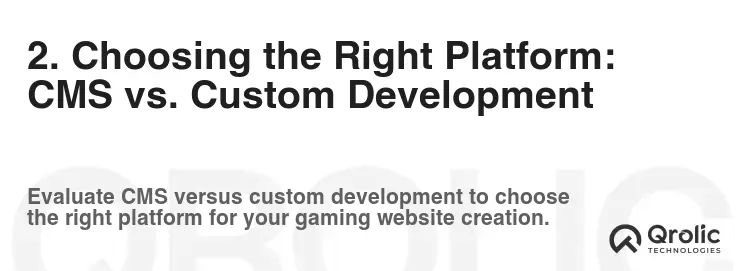
Selecting the right platform is a critical decision. This will heavily influence the flexibility, cost, and maintenance of your website.
2.1 Content Management Systems (CMS): Power in Simplicity
- What is a CMS? A CMS is a software application that allows you to create, manage, and modify website content without requiring technical expertise. It provides a user-friendly interface for adding pages, blog posts, images, and videos.
- Popular CMS options:
- WordPress: The most popular CMS in the world, known for its flexibility, extensive plugin library, and large community. Ideal for blogs, portfolio websites, and small to medium-sized businesses.
- Joomla: A powerful CMS with advanced features, suitable for complex websites with custom requirements.
- Drupal: A highly customizable CMS favored by developers for its security and scalability. Best for enterprise-level websites with specific needs.
- Squarespace: A user-friendly website builder with a drag-and-drop interface and pre-designed templates. Good for small businesses and portfolio websites.
- Wix: Another popular website builder with a simple interface and a wide range of templates. Suitable for beginners and small businesses.
- Benefits of using a CMS:
- Easy to use: No coding knowledge required to create and manage content.
- Cost-effective: CMS platforms are generally free or have affordable pricing plans.
- Flexible: A wide range of themes and plugins allow you to customize your website.
- SEO-friendly: Many CMS platforms have built-in SEO features and plugins.
- Community support: Large communities offer support and resources for troubleshooting.
- Considerations when choosing a CMS:
- Ease of use: How comfortable are you with the interface?
- Customization options: Does the CMS offer the flexibility you need?
- Scalability: Can the CMS handle future growth?
- Security: How secure is the CMS against hacking and malware?
- Support: What kind of support is available?
2.2 Custom Website Development: Tailored to Perfection
- What is custom website development? Custom website development involves building a website from scratch using programming languages like HTML, CSS, JavaScript, and server-side languages like PHP, Python, or Node.js.
- Benefits of custom development:
- Complete control: You have full control over the design, functionality, and performance of your website.
- Unique design: Create a website that perfectly reflects your brand identity.
- Custom features: Develop specific features tailored to your business needs.
- Scalability: Easily scale your website as your business grows.
- Performance optimization: Optimize your website for speed and performance.
- Drawbacks of custom development:
- Higher cost: Custom development is more expensive than using a CMS.
- Longer development time: It takes more time to build a website from scratch.
- Technical expertise required: You need to hire experienced developers.
- Maintenance: You are responsible for maintaining and updating the website.
- When to choose custom development:
- You need a highly customized website with specific features.
- You require a high level of control over design and functionality.
- You have a large budget and can afford to hire experienced developers.
- You anticipate significant growth and need a highly scalable website.
2.3 Hosting Options: Where Your Website Lives
- Shared Hosting: The most affordable option, where your website shares server resources with other websites. Suitable for small businesses and startups with limited traffic.
- VPS Hosting (Virtual Private Server): You get a virtual server with dedicated resources, offering more control and performance than shared hosting. Ideal for growing businesses with moderate traffic.
- Dedicated Hosting: You have an entire server dedicated to your website, providing maximum performance and control. Best for large businesses with high traffic and demanding requirements.
- Cloud Hosting: Your website is hosted on a network of servers, offering scalability, reliability, and pay-as-you-go pricing. A good option for businesses with fluctuating traffic.
- Considerations when choosing a hosting provider:
- Uptime: Choose a provider with a high uptime guarantee (at least 99.9%).
- Speed: Look for fast servers and content delivery networks (CDNs).
- Security: Ensure the provider has robust security measures in place.
- Support: Choose a provider with responsive and helpful customer support.
- Scalability: Can the provider easily scale your resources as your business grows?
- Price: Compare pricing plans and features from different providers.
3. Designing a Captivating Gaming Company Website
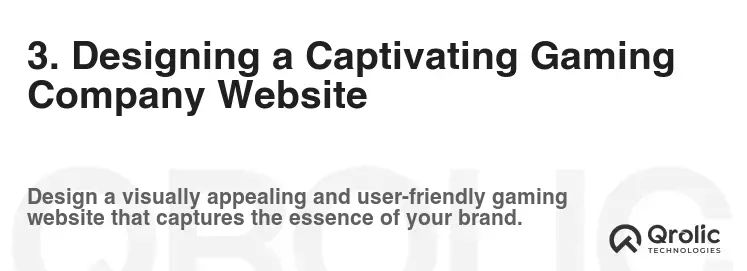
Your website’s design is your first impression. It needs to be visually appealing, user-friendly, and reflective of your brand. Good entertainment design is essential to attract visitors to your site.
3.1 Choosing a Theme or Template (if using a CMS)
- Free vs. Premium Themes: Free themes are a good starting point, but premium themes often offer more features, customization options, and support.
- Gaming-Specific Themes: Look for themes specifically designed for gaming companies, as they often include features like game showcases, news sections, and community forums.
- Responsive Design: Ensure the theme is responsive, meaning it adapts to different screen sizes (desktops, tablets, and mobile phones).
- Customization Options: Choose a theme that offers ample customization options, allowing you to tailor the design to your brand.
- Page Builder Compatibility: If you want to use a drag-and-drop page builder, ensure the theme is compatible.
3.2 Creating a Visually Appealing Layout
- Use a clear and consistent layout: Avoid clutter and ensure that your content is easy to read and navigate.
- Prioritize key information: Highlight your most important content (e.g., your latest game release) above the fold (the area visible without scrolling).
- Use whitespace effectively: Whitespace (or negative space) helps to improve readability and create a sense of balance.
- Implement visual hierarchy: Use different font sizes, colors, and spacing to guide the user’s eye.
- Use high-quality images and videos: Invest in professional-quality visuals to showcase your games and company.
3.3 Branding: Colors, Fonts, and Imagery
- Choose a color palette that reflects your brand: Consider the psychology of colors and choose a palette that evokes the desired emotions.
- Select fonts that are legible and consistent: Use a maximum of two or three fonts and ensure they are readable on all devices.
- Use high-quality images and graphics: Avoid using stock photos that look generic.
- Create a logo that represents your brand: Your logo should be simple, memorable, and versatile.
- Maintain consistency throughout your website: Use the same colors, fonts, and imagery across all pages.
3.4 User Experience (UX) Considerations
- Intuitive Navigation: Ensure your navigation is clear and easy to use.
- Fast Loading Times: Optimize your website for speed to prevent users from leaving.
- Mobile-Friendliness: Design your website to be fully responsive and accessible on mobile devices.
- Accessibility: Make your website accessible to users with disabilities by following accessibility guidelines (WCAG).
- Clear Call-to-Actions (CTAs): Use clear and concise CTAs to encourage users to take action (e.g., “Download Now,” “Learn More,” “Join the Community”).
4. Content is King: Creating Engaging Content for Gamers

Content is the heart and soul of your website. It’s what attracts visitors, keeps them engaged, and ultimately converts them into customers or fans.
4.1 Showcasing Your Games: Portfolio and Game Pages
- Create dedicated game pages: Each game should have its own page with detailed information, screenshots, videos, and reviews.
- Use high-quality visuals: Showcase your games with stunning screenshots, trailers, and gameplay videos.
- Provide detailed game descriptions: Highlight the key features, gameplay mechanics, and story elements.
- Include customer reviews and testimonials: Social proof can help to build trust and credibility.
- Offer download links or purchase options: Make it easy for visitors to download or purchase your games.
- Integrate social sharing buttons: Allow users to easily share your games on social media.
4.2 News and Blog: Keeping Your Audience Engaged
- Publish regular blog posts: Share news, updates, behind-the-scenes content, and industry insights.
- Write engaging and informative articles: Provide valuable content that your audience will find interesting and useful.
- Use relevant keywords: Optimize your blog posts for search engines by using relevant keywords.
- Promote your blog posts on social media: Share your latest articles on social media to reach a wider audience.
- Encourage comments and feedback: Foster a sense of community by encouraging users to comment on your blog posts.
4.3 About Us Page: Telling Your Story
- Share your company’s story: Tell your audience about your company’s history, mission, and values.
- Introduce your team: Highlight the skills and experience of your team members.
- Showcase your company culture: Give visitors a glimpse into your company’s work environment and values.
- Use high-quality photos and videos: Visuals can help to make your “About Us” page more engaging.
- Include testimonials from satisfied customers or partners: Social proof can help to build trust and credibility.
4.4 Careers Page: Attracting Top Talent
- Highlight your company culture: Showcase your company’s values, work environment, and benefits.
- List current job openings: Provide detailed job descriptions and application instructions.
- Make it easy for candidates to apply: Use an online application form or provide clear instructions on how to apply.
- Include testimonials from current employees: Let your employees speak for your company and its culture.
- Promote your careers page on social media: Share job openings on social media to reach a wider audience.
4.5 Contact Us Page: Making it Easy to Connect
- Provide a contact form: Allow visitors to easily send you a message.
- List your email address and phone number: Make it easy for visitors to contact you directly.
- Include your physical address (if applicable): If you have a physical location, include your address on the “Contact Us” page.
- Integrate a map: Show visitors where your company is located.
- Respond to inquiries promptly: Answer emails and phone calls in a timely manner.
5. Optimizing for Search Engines (SEO): Getting Found Online
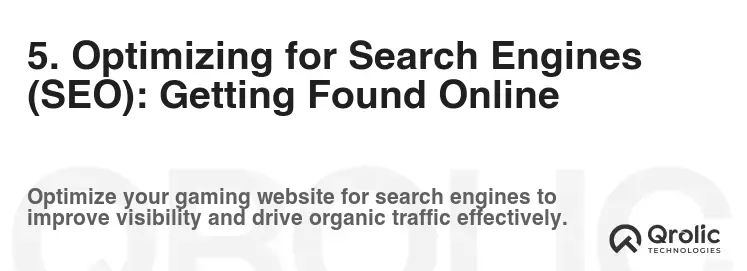
SEO is the process of optimizing your website to rank higher in search engine results pages (SERPs). This is crucial for driving organic traffic to your website.
5.1 Keyword Research: Finding the Right Terms
- Identify relevant keywords: Use keyword research tools (e.g., Google Keyword Planner, Ahrefs, SEMrush) to find keywords that your target audience is searching for.
- Focus on long-tail keywords: Long-tail keywords are longer and more specific phrases that have lower search volume but higher conversion rates.
- Analyze your competitors’ keywords: See what keywords your competitors are targeting.
- Create a keyword strategy: Develop a plan for targeting specific keywords on different pages of your website.
5.2 On-Page Optimization: Making Your Content SEO-Friendly
- Use keywords in your titles and headings: Include relevant keywords in your page titles (H1 tags) and subheadings (H2, H3 tags).
- Write compelling meta descriptions: Meta descriptions are short summaries of your pages that appear in search results.
- Optimize your images: Use descriptive file names and alt tags for your images.
- Use internal and external links: Link to other relevant pages on your website (internal links) and to reputable websites (external links).
- Ensure your website is mobile-friendly: Google prioritizes mobile-friendly websites in search results.
- Improve your website’s loading speed: Faster websites rank higher in search results.
- Use a sitemap: Submit a sitemap to Google to help them crawl your website more effectively.
5.3 Off-Page Optimization: Building Authority
- Build high-quality backlinks: Backlinks are links from other websites to your website. The more high-quality backlinks you have, the higher your website will rank in search results.
- Guest blogging: Write guest posts for other websites in your industry and include a link back to your website.
- Social media marketing: Promote your website on social media to drive traffic and build brand awareness.
- Online directory listings: List your website in relevant online directories.
- Participate in online communities: Engage in online communities related to gaming and share your expertise.
5.4 Technical SEO: Ensuring a Healthy Website
- Ensure your website is crawlable: Make sure search engine bots can easily crawl and index your website.
- Fix broken links: Regularly check your website for broken links and fix them.
- Use HTTPS: Secure your website with HTTPS to protect user data.
- Optimize your website’s structure: Use a clear and logical website structure to make it easy for search engines to understand your content.
- Monitor your website’s performance: Use Google Analytics and Google Search Console to track your website’s performance and identify areas for improvement.
6. Testing and Launching Your Website: Ready, Set, Go!

Before you launch your website, it’s crucial to thoroughly test it to ensure everything is working correctly.
6.1 Cross-Browser and Device Testing
- Test your website on different browsers: Ensure your website looks and functions correctly on popular browsers like Chrome, Firefox, Safari, and Edge.
- Test your website on different devices: Check your website on different screen sizes and devices, including desktops, laptops, tablets, and smartphones.
- Use browser testing tools: Use online browser testing tools to automate the testing process.
6.2 Performance Testing: Speed and Load Times
- Test your website’s loading speed: Use tools like Google PageSpeed Insights and GTmetrix to check your website’s loading speed.
- Optimize your images: Compress your images to reduce their file size without sacrificing quality.
- Enable browser caching: Enable browser caching to store static files on the user’s computer.
- Use a content delivery network (CDN): Use a CDN to distribute your website’s content across multiple servers, improving loading speed for users around the world.
6.3 User Testing: Getting Feedback
- Ask friends and family to test your website: Get feedback from people who are not familiar with your website.
- Conduct usability testing: Observe users as they interact with your website and identify any usability issues.
- Use online survey tools: Use online survey tools to collect feedback from a larger audience.
- Analyze user behavior: Use Google Analytics to track user behavior and identify areas for improvement.
6.4 Final Checks Before Launch
- Double-check all links: Ensure all links on your website are working correctly.
- Review your content: Proofread all of your content for errors and typos.
- Test your contact form: Make sure your contact form is working correctly and that you are receiving submissions.
- Backup your website: Create a backup of your website before launching it.
6.5 Launching Your Website: Making it Live
- Point your domain name to your hosting server: Update your domain name’s DNS records to point to your hosting server.
- Upload your website files to your hosting server: Upload all of your website files to your hosting server.
- Test your website: Once your website is live, test it thoroughly to ensure everything is working correctly.
- Submit your website to search engines: Submit your website to Google and other search engines to help them crawl and index your website.
- Promote your website on social media: Share your website on social media to drive traffic and build brand awareness.
7. Post-Launch Maintenance and Growth: Keeping Your Website Alive

Launching your website is just the beginning. You need to continuously maintain and improve it to keep it relevant and engaging.
7.1 Regular Content Updates
- Publish new blog posts regularly: Keep your blog updated with fresh content to attract new visitors and keep existing visitors engaged.
- Update your game pages: Keep your game pages updated with the latest information, screenshots, and videos.
- Create new landing pages: Create new landing pages to target specific keywords and attract new leads.
7.2 Monitoring Website Performance
- Track your website’s traffic: Use Google Analytics to track your website’s traffic and identify trends.
- Monitor your website’s search engine rankings: Use keyword tracking tools to monitor your website’s search engine rankings.
- Track your website’s conversions: Track your website’s conversions to measure the effectiveness of your marketing efforts.
- Identify areas for improvement: Use data to identify areas where you can improve your website’s performance.
7.3 Security Updates and Backups
- Keep your CMS and plugins updated: Regularly update your CMS and plugins to protect your website from security vulnerabilities.
- Create regular backups: Create regular backups of your website to protect your data in case of a disaster.
- Use a security plugin: Use a security plugin to protect your website from hacking attempts.
7.4 Engaging with Your Community
- Respond to comments and messages: Respond to comments and messages on your website and social media.
- Participate in online communities: Engage in online communities related to gaming and share your expertise.
- Run contests and giveaways: Run contests and giveaways to engage your audience and generate leads.
- Host online events: Host online events like webinars and Q&A sessions to connect with your audience.
7.5 A/B Testing and Optimization
- Conduct A/B tests: Use A/B testing to test different versions of your website and identify which ones perform best.
- Optimize your website based on data: Use data from A/B tests and website analytics to optimize your website for conversions.
- Continuously improve your website: The process of website optimization is never complete. Continuously test and improve your website to achieve your goals.
8. Leverage Qrolic Technologies for Your Gaming Website
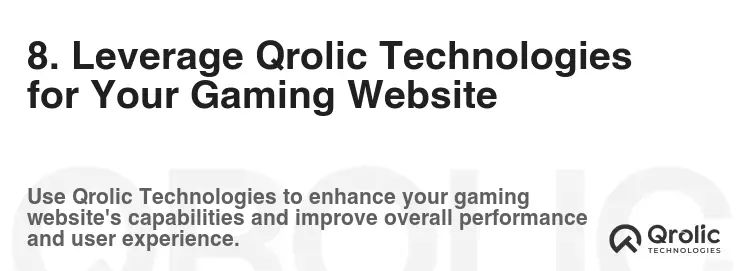
Qrolic Technologies (https://qrolic.com/) offers comprehensive web development and digital marketing services specifically tailored for the gaming industry. Partnering with Qrolic Technologies can provide your gaming company with:
- Custom Website Development: Build a unique and engaging website that perfectly represents your brand and showcases your games. Their team of experienced developers can create custom features and functionalities to meet your specific needs.
- Responsive Web Design: Ensure your website is fully responsive and accessible on all devices, providing a seamless user experience for gamers on desktops, tablets, and smartphones.
- SEO Optimization: Improve your website’s search engine rankings and drive organic traffic with Qrolic Technologies’ SEO expertise. They can conduct keyword research, optimize your content, and build high-quality backlinks to increase your website’s visibility.
- Content Marketing: Engage your audience with compelling and informative content. Qrolic Technologies can help you create blog posts, articles, and videos that will attract new visitors and keep existing visitors engaged.
- Social Media Marketing: Build brand awareness and connect with your target audience on social media. Qrolic Technologies can manage your social media accounts, create engaging content, and run targeted advertising campaigns to reach gamers.
- E-commerce Integration: Sell your games directly from your website with seamless e-commerce integration. Qrolic Technologies can help you set up an online store, manage payments, and handle shipping.
- Website Maintenance and Support: Ensure your website is always up-to-date and running smoothly with Qrolic Technologies’ website maintenance and support services. They can provide security updates, backups, and technical support to keep your website safe and reliable.
By partnering with Qrolic Technologies, you can focus on developing amazing games while they handle the technical aspects of your website and online marketing. Their expertise and experience in the gaming industry can help you reach a wider audience, generate more leads, and ultimately grow your business.
9. Legal Considerations

Creating a gaming company website also involves adhering to legal requirements to protect your business and users.
- Privacy Policy: This outlines how you collect, use, and protect user data. It’s crucial, especially with regulations like GDPR and CCPA. Clearly state what data you collect (e.g., email addresses, IP addresses), how you use it (e.g., marketing, analytics), and how users can control their data.
- Terms of Service (ToS): This agreement governs the use of your website and services. It should address acceptable use, intellectual property rights, liability limitations, and dispute resolution. Specifically, state what users are allowed to do on your site and what actions are prohibited (e.g., hacking, distributing malware).
- Copyright: Protect your original content (e.g., game assets, blog posts) by clearly stating your copyright ownership. Include copyright notices in your website footer and potentially watermarks on images and videos. Respect the copyrights of others by obtaining permission or licenses for any third-party content you use.
- EULA (End User License Agreement): If you distribute games directly through your website, you’ll need an EULA. This agreement governs the use of your game software, outlining licensing terms, restrictions, and disclaimers.
- Data Security: Implement robust security measures to protect user data from unauthorized access and breaches. Use HTTPS encryption, regularly update your security protocols, and consider penetration testing to identify vulnerabilities.
- Age Restrictions: If your games are targeted at a specific age group, implement age verification mechanisms to comply with regulations. Use age gates or require parental consent for younger users.
- Gambling Laws: If your games involve real-money gambling, comply with all relevant gambling laws and regulations in the jurisdictions where your games are offered. This includes obtaining licenses, implementing responsible gambling measures, and verifying user identities.
It is highly recommended to consult with a legal professional to ensure your website and business practices are compliant with all applicable laws and regulations. This will minimize risks and protect you from potential legal issues.
10. Final Thoughts
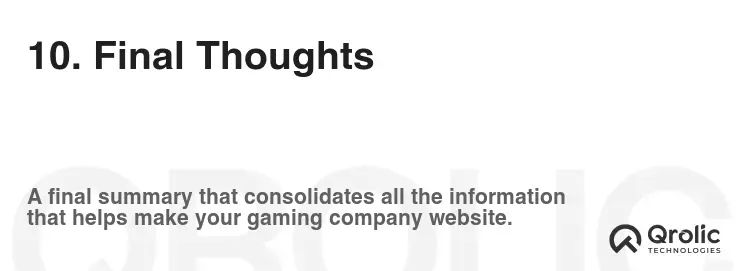
Creating a successful gaming company website requires careful planning, execution, and ongoing maintenance. From defining your target audience and selecting the right platform to designing a captivating website and optimizing for search engines, each step is crucial for achieving your goals. By following this step-by-step tutorial and leveraging the expertise of companies like Qrolic Technologies, you can create a website that attracts gamers, showcases your talent, and drives the success of your gaming company. Remember, the gaming industry is dynamic, so continuous adaptation and innovation are key to staying ahead of the competition.
